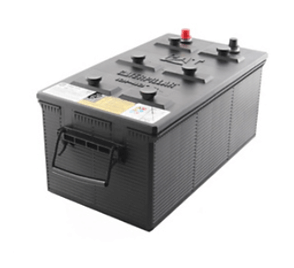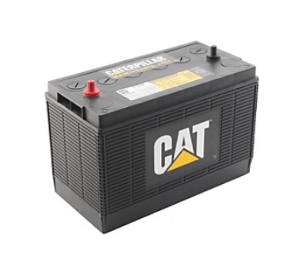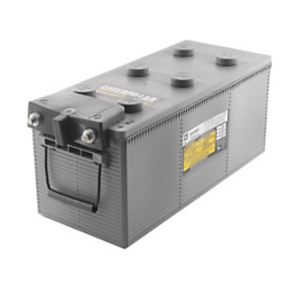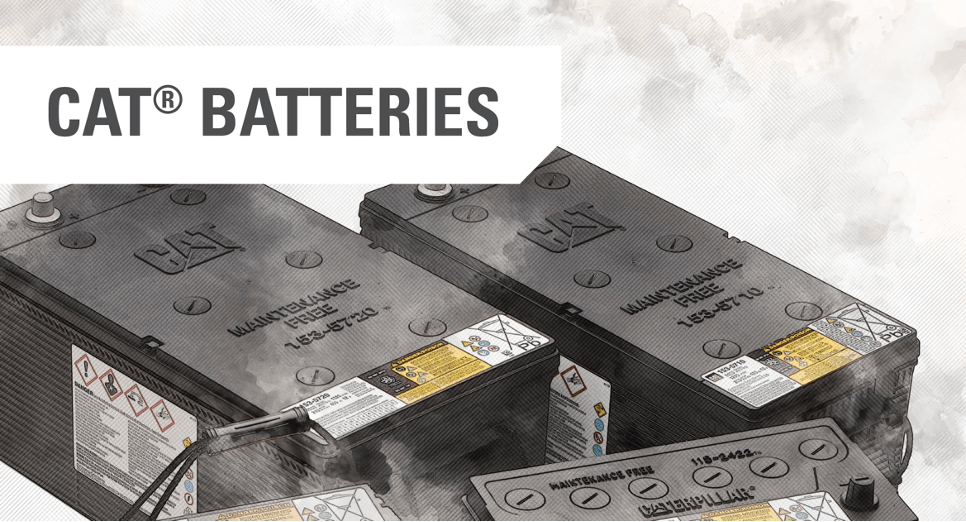Your One-Stop Guide to Cat® Batteries
The Basics of Cat Batteries
Millions of people around the world rely on the durability and reliability of Cat batteries to power them through daily work. Cat batteries have been tested and proven to meet some of the highest standards set by the industry, including vibration tests for 100+ hours, freezing tests and wet environment testing.
Rest assured, you can trust Cat batteries. But, how do you know which battery is best for your machine? And what can you do to make sure it stays in top shape, operating at its best? These answers and more are uncovered in the video and guide below.
Types of Batteries
If you don’t know a lot about batteries, the number of options can be overwhelming. What’s most important to consider when choosing a battery is your equipment type and use case. Here are some popular battery types and the scenarios they serve best.

Heavy Duty Batteries:
Cat’s heavy duty batteries are designed to work in some of the toughest conditions and are factory installed on all Cat machines and generator sets. These batteries have a high power output and a high vibration resistance compared to standard machine batteries.
 General Duty (GD) Batteries:
General Duty (GD) Batteries:
General duty batteries are designed for high performance when used on light-to-medium impact Cat and mixed fleet equipment, as well as truck, automotive and recreational vehicles. They can range in voltage from 6-12 volts.
 Uninterruptible Power Supply (UPS) Batteries:
Uninterruptible Power Supply (UPS) Batteries:
Uninterruptible power supply batteries are designed to provide power instantly and continually, protecting sensitive computer and manufacturing equipment against damage from sudden changes in voltage or current. UPS batteries can also power critical facilities such as hospitals during power outages or fluctuations.
Maintenance-Free (MF) Batteries:
Maintenance-free batteries can include any of the above types but are defined by calcium added to the negative and positive plates of the battery, reducing the risk of both an explosion and corrosion at the battery terminals. It is still good practice to service maintenance-free batteries, as maintenance-free refers only to the constitution of the battery plates.
Maintenance-Free Accessible (MFA) Batteries:
The difference between maintenance-free and maintenance-free accessible batteries is the presence of caps, which allow access into the battery to monitor fluid levels. The ability to access the inner workings of an MFA battery gives them a longer useful life than their MF counterparts.
Low-Maintenance Batteries:
Low-maintenance batteries use antimony on the positive plate and calcium on the negative plate to reduce heat and water loss. The only maintenance required is ensuring the fluid levels are above the battery plates.
Wet and Dry Batteries:
Wet batteries are ready for use right off the shelf, are cheaper and often perform better than dry batteries. In addition, wet batteries often perform better in more extreme environments but are often considered hazardous materials. As such, dry batteries are easier to transport and have a longer lifespan. Cat does not sell acid for dry batteries.
Batteries are also often sold with statistics regarding their use, including:
- Cold Cranking Amps (CCA): Also called cranking power or starting power, a measure of how well a battery delivers current to start an engine at 0 F (-17.8 C). The higher the CCA, the faster the vehicle will start.
- Reserve Capacity (RC): The number of minutes a fully charged battery at 80 F (27 C) will supply power if the charging system fails. The greater the RC, the longer you can operate your vehicle if your alternator fails.
- Cranking Amps (CA): A measure of a battery’s ability to start an engine at 32 F (0 C). Due to the difference in temperature between CCA and CA, when a manufacturer uses CA to rate their battery, the rating can be artificially inflated by ~20%. As such, it is important to recognize the difference between CCA and CA.
Maintenance and Storage
You can opt for either slow or fast charging when charging a battery. Slow charging a battery involves charging the battery with 1 amp per positive plate cell for 12-24 hours, while fast charging uses 40 amps for 1-2 hours. When fast charging, you risk boiling the water within the battery or buckling the batteries’ plates, so slow charging is always preferred. A trickle charger is a slow charger that can be used to maintain a state of charge in a battery for a long period.
When your battery needs water, add distilled water if possible. If distilled water is unavailable, tap water can be used, but hard water should be avoided. Do not add acid to an activated battery.
When storing your battery for extended periods, it’s best to disconnect the battery cables to prevent a loss of charge over time. The best temperature for battery storage is between 40-50 F (5-10 C) if possible, but always above freezing. Before storing your battery, make sure it is at least partially charged.
If your battery dries out in storage and it is an accessible battery, you can attempt to refill it with water, but it may not return to full-rated performance. It is usually preferable to buy a new battery instead of using “pills” to rejuvenate dead batteries. Do not try to use a trickle charger to revive a dead battery.
Buying and Installation
When purchasing and installing a battery, make sure you are purchasing according to the specifications required by your application. There is no one-size-fits-all solution to buying a battery for every industry; the use cases of the battery require different batteries for different applications. When buying and installing a battery, you can use the Cat Batteries Cross Reference Guide for assistance or consult with a Boyd CAT equipment expert.
Lifespan and Durability
Batteries wear out over time due to the lead paste material within the battery breaking down and accumulating, eventually shorting out the battery. This accumulation also causes corrosion, weakening the battery over time. In addition, overcharging, undercharging, excessive vibrations and neglect can all contribute to or cause battery failure.
When buying a higher versus a lower-rated battery, it is recommended to buy a higher-rated battery due to its longer lifespan. Higher-rated batteries start engines more easily and, in doing so, use less of their capacity. They cycle less frequently and can start your engine with a low charge more often than a lower-rated battery with the same charge.
Learn More
For the toughest, highest quality batteries on the market for your applications and industry, there is no substitute for Cat. Contact Boyd CAT today to learn more about Cat’s batteries or other heavy equipment and machinery.

